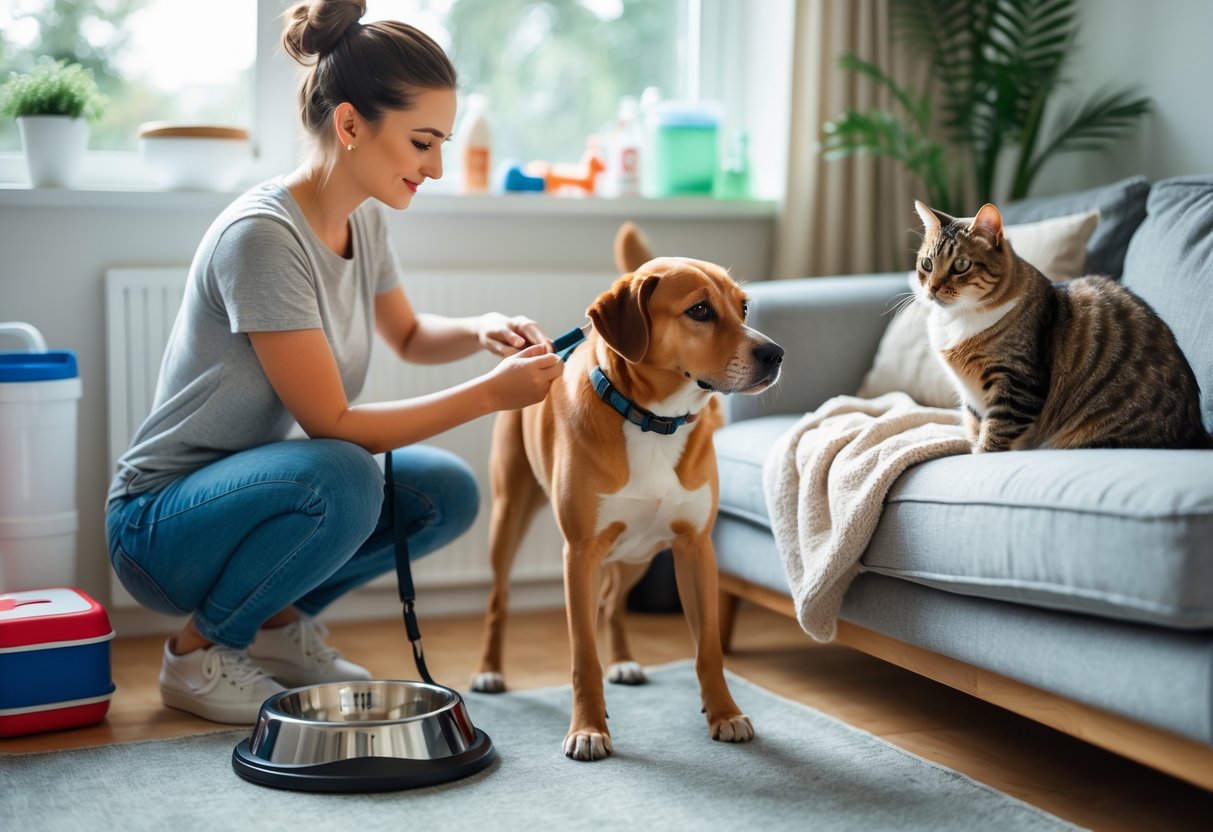Owning a pet is rewarding, but even the most caring owners slip up sometimes without knowing it.
These everyday errors can impact your pet’s health and happiness, often in small ways that are easy to miss.
From overfeeding to missing subtle signs of illness, these mistakes are surprisingly easy to make once you know what to watch for.
Knowing what habits to change really can help you give your pet the best care possible—at least, that’s the goal, right?
Common Mistakes Pet Owners Don’t Realize They’re Making

You might think your pet is healthy because they look and act fine, but some common care mistakes can harm them before you notice anything’s wrong.
Paying closer attention to feeding habits, health check-ups, and how your pet behaves or interacts can prevent a lot of headaches down the road.
Neglecting Regular Vet Visits
Skipping regular vet visits is a big one. A lot of illnesses don’t show clear signs until things are already advanced.
You might miss early warnings of dental disease, infections, or organ problems if you wait too long.
Taking your pet to the vet once a year helps catch issues before they become severe. Vets can update vaccines and recommend care based on your pet’s age, breed, and lifestyle.
If your pet is older or has a chronic illness, visits should be more frequent. Sticking to these appointments really does protect your pet’s long-term health.
Overfeeding or Underfeeding Pets
Feeding your pet the wrong amount is surprisingly common and can be risky. Overfeeding leads to obesity, which brings diabetes, joint issues, and a shorter life.

Underfeeding causes malnutrition and weakens the immune system. It’s all about balance, but it’s easy to get wrong.
Measure your pet’s food and follow the vet’s advice. Pets need different amounts depending on their age, breed, and how active they are.
Treats? Keep them limited, or you’ll be adding a lot of extra calories without realizing it.
Always choose food that fits your pet’s needs. Skip the table scraps and human food—most of it just upsets their stomach or worse.
Ignoring Behavioral Issues
Problems like chewing, barking, or aggression might seem minor at first, but they can be signs of stress or lack of training.
If you ignore these, they tend to get worse and can really hurt your pet’s wellbeing.
Set clear rules and routines. Pets thrive with consistency and boundaries, even if it feels strict sometimes.
If your pet seems anxious or fearful, it’s better to address it quickly than let things spiral.
If behavior issues stick around, don’t be afraid to ask for help from a trainer or your vet. There’s no shame in it.
Leaving Pets Alone for Extended Periods
Pets—especially dogs—need companionship and interaction. Leaving them alone for hours on end can lead to loneliness, anxiety, or destructive habits.
Long stretches alone often create stress, which affects both health and mood. It’s not great for anyone.
Make sure your pet gets enough mental and physical stimulation during the day. If you’re gone a lot, maybe look into pet sitters, dog walkers, or even daycare.
Regular interaction supports your pet’s emotional and physical health, and honestly, it just makes life better for both of you.
Feeding and Nutrition Pitfalls

Feeding your pet sounds simple, but mistakes like giving too much or the wrong food can sneak up on you.
Knowing how much to feed, what treats to allow, and how to spot signs of poor nutrition makes a world of difference.
Understanding Proper Portion Sizes
Feed your pet based on their size, age, and activity level. Overfeeding leads to weight gain and health problems; underfeeding causes weakness and nutrient gaps.
Start with the guidelines on the food label, but don’t be afraid to adjust if your pet’s weight changes.
Weigh your pet regularly and use measuring cups or a kitchen scale to avoid guessing. Feeding on a regular schedule with fixed amounts helps prevent begging and keeps digestion steady.
Risks of Human Food and Excess Treats
Giving pets table scraps or too many treats adds calories fast. Human food is often loaded with fat, salt, or sugar, and can upset your pet’s stomach or cause long-term issues.
Limit treats to less than 10% of daily calories. Pick healthy, pet-safe options instead of leftovers.
Steer clear of toxic foods like chocolate, onions, grapes, and anything with artificial sweeteners. It’s just not worth the risk.
Addressing Weight Management
Overfeeding is the main reason pets become obese. If your pet is overweight, their risk of diabetes, joint problems, and heart disease goes up fast.
Underfeeding isn’t good either—it can cause muscle loss and low energy.
Control portions and make sure your pet gets regular exercise. If you’re unsure, ask your vet for a feeding plan and ideal weight target.
Tracking your pet’s weight every few weeks helps you catch problems before they get out of hand.
Recognizing Signs of Malnutrition
Watch for dull fur, low energy, weight loss, or diarrhea—these could mean your pet isn’t getting the right nutrients.
Malnutrition can happen with poor-quality food, an unbalanced diet, or certain health issues.
If you see any of these signs, double-check the diet and talk to your vet. Feeding a balanced, high-quality food for your pet’s life stage is key.
Addressing Behavioral and Mental Health Needs

Your pet’s behavior and mental health shape their happiness—and let’s be honest, your relationship too.
Consistent training, mental activity, and social experiences all help build a balanced pet and avoid common issues.
Effective Use of Positive Reinforcement
Reward good behavior right when it happens. Use treats, praise, or play to show your pet what you like.
Punishment tends to backfire, causing fear or anxiety. It’s better to focus on clear commands and positive feedback.
Be consistent with your timing and rewards. Mixed signals just confuse pets and slow everything down.
For example, if your dog sits when asked, give a treat within seconds so they connect the dots.
Positive reinforcement really does help reduce things like jumping, barking, or chewing by replacing bad habits with better ones.
Providing Sufficient Mental Stimulation
Pets need more than just walks—they crave mental challenges to stay calm and happy.
Try puzzle toys or training games that make your pet think. Rotate toys often to keep things interesting.
Bored pets are more likely to act out or get anxious. Mental stimulation eases stress and keeps those problems at bay.
Set aside time every day for interactive play or training. Even a few minutes can make a difference.
Early Socialization Strategies
Socialization helps your pet adapt to people, animals, and new places. Start when they’re young if you can.
Expose your pet to different sounds, sights, and experiences in a gentle, controlled way. Use positive reinforcement to make it a good experience.
Proper socialization reduces fear, aggression, and anxiety down the line. It lays the groundwork for confident behavior.
If your pet shows fear or aggression, working with a trainer or behaviorist early can really help.
Maintaining Overall Well-Being and Safety

Keeping your pet healthy and safe means paying attention to daily care and your home environment.
Simple steps in grooming, safety, and social interaction can prevent a lot of headaches.
Regular Grooming and Dental Care
Brush your pet’s fur regularly to avoid mats and skin issues. Grooming also lets you spot ticks, fleas, or changes early.
Some breeds need more frequent brushing, but most dogs and cats do well with weekly care.
Dental health matters too. Brushing your pet’s teeth several times a week reduces plaque and prevents gum disease.
If brushing is tough, try dental chews or toys designed to help keep teeth clean.
Keeping up with grooming and dental care makes your pet more comfortable and stops small problems from getting worse.
Pet-Proofing Your Home
Your home should be safe for your pet to explore. Remove or secure electrical cords, toxic plants, and anything small they might swallow.
Keep cleaning supplies, meds, and harmful foods out of reach. Check for gaps or holes where pets could escape or get stuck.
Gates or barriers can keep pets out of dangerous spots like stairs or kitchens. These steps reduce the risk of accidents when you’re not looking.
Preventing Extended Isolation
Leaving pets alone for long hours? That can really mess with their stress levels and even their health. Dogs, in particular, crave regular interaction, walks, and a bit of mental stimulation—otherwise, they’re just not themselves.
If your schedule keeps you out more than you’d like, it’s smart to arrange for a pet sitter, dog walker, or even a trusted friend to stop by. When pets get bored, they sometimes act out or get anxious, and nobody wants to come home to that.
Try to leave toys around that keep them active or give them comfort while you’re away. Honestly, it’s best not to leave pets isolated for more than 4 to 6 hours, though it can vary depending on their age and breed.
At the end of the day, finding ways to keep your furry friend engaged and cared for when you’re gone isn’t just about avoiding chewed shoes—it’s about giving them a life that’s happy and secure. Isn’t that what we all want for our pets?
Conclusion
Honestly, most pet owners have made at least one of these mistakes—I know I have. The good news is, a few simple changes can make a huge difference in your pet’s life. Regular check-ups, balanced feeding, a bit of training, and a safe, loving environment go a long way. It’s not about being perfect, just about paying attention and learning as you go. After all, our pets depend on us, and they’re worth every effort. So, maybe take a moment to look at your daily routine—your furry friend will thank you for it.


